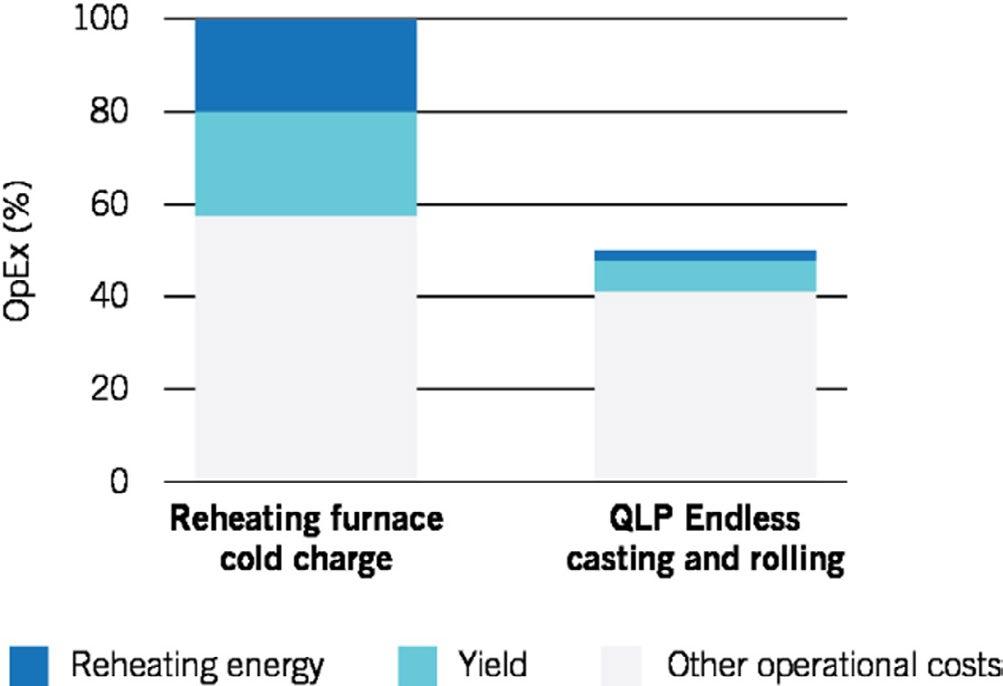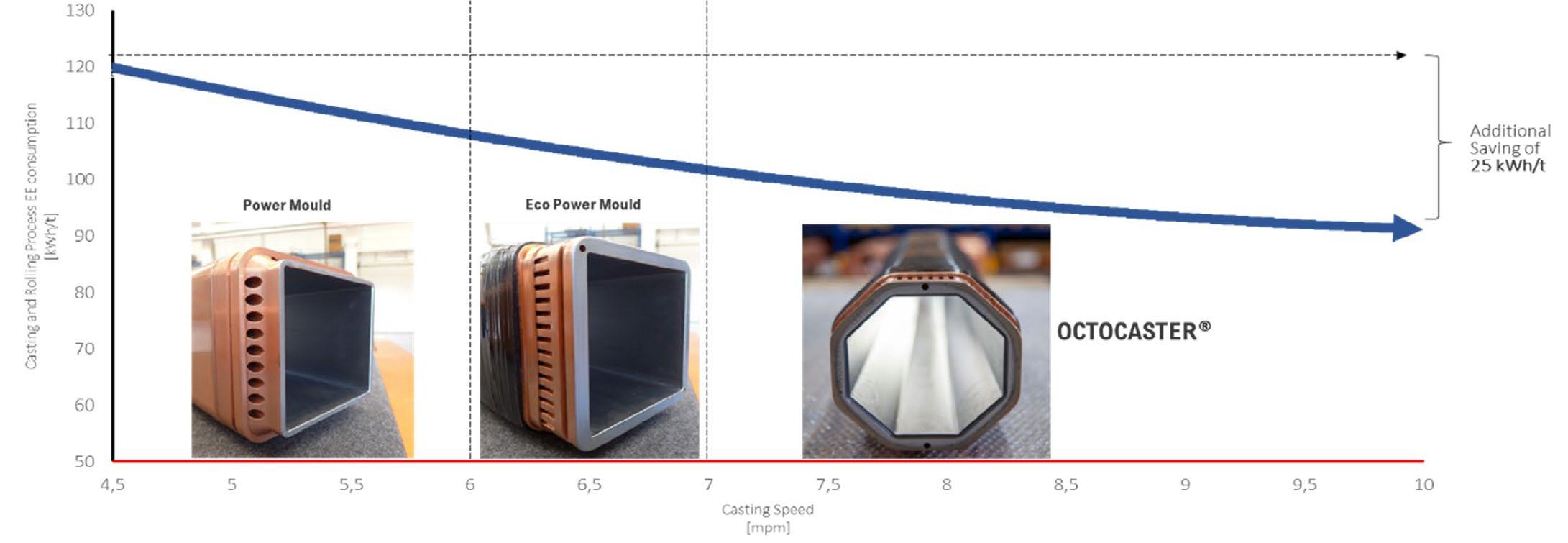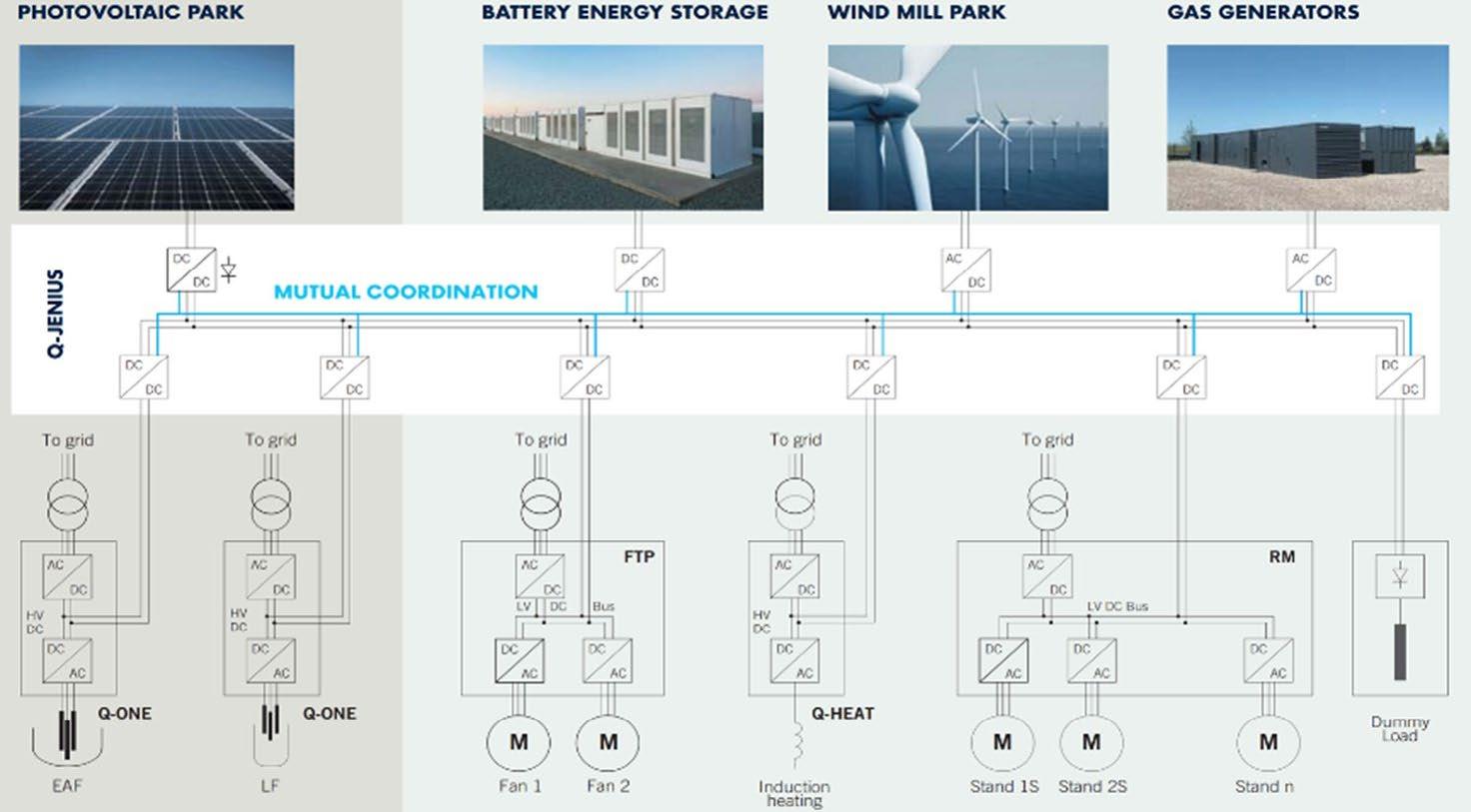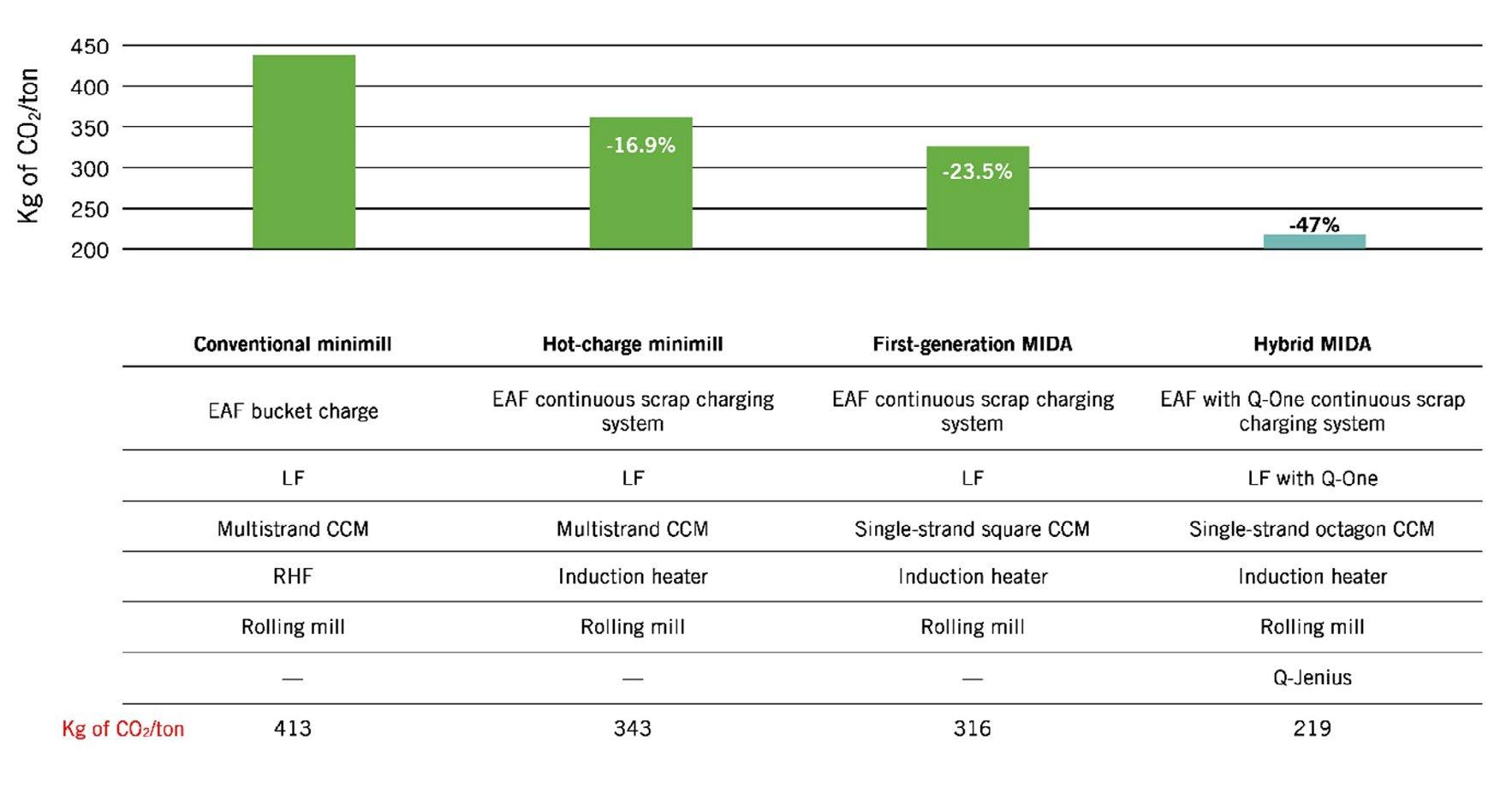
7 minute read
The Revolutionary MIDA Hybrid Minimill for a competitive green steel production
edited by: J. Shuli, V. Collini
After more than 20 years in research, development and consolidation of the endless casting and rolling process, Danieli has set new standards in long steel production as the most efficient and cost-effective way to produce it with the socalled MIDA—Minimill Danieli—Plant.
The first pillar of the whole technology is Danieli’s Octocaster, with its unique capability to cast billets at speeds up to 10 mpm and 99% plant yield, making up-to-250-tph productivities possible, with one single casting and rolling strand. Second pillar of the technology is the Automation system which, thanks to the most advanced process control solution and technological packages, ensures the proper synchronization in casting and rolling.
Third is reduced Carbon footprint, obtained thanks to several unique technologies such as Q-HEAT electric induction heating, Q-ONE, the digital power feeder of the Electrical Arc and Q-JENIUS, which enables a controlled routing of “green” energies which, together with Danieli Digimelter, maximizes the productivity with minimum OpEx and environmental impact.
Moreover, Danieli adds clean energy to the MIDA, finding a perfect synergy that enhances competitiveness and production sustainability named MIDA Hybrid, using the most modern and reliable solutions for the production of environmentally clean and cost-effective steel products.
Introduction
In the early 2000s, Danieli industrially developed the concept of MIDA QLP® (Minimill Danieli for quality long products, featuring Endless Casting and Rolling technology), the extremely compact minimill for long products with a single casting strand directly connected to the rolling mill. This eliminates the need for billets to be cut, then cooled and stored in a billet yard, and then reheated in a gas-fired reheating furnace prior to rolling. Just a single-strand, high-speed caster producing an endless billet that is immediately hot-rolled, in a continuous process for hours and hours.
In 2007, Sovel Sidenor was the first steelmaker to operate Endless Casting and rolling, revamping one conventional caster strand. Since 2009, CMC has been the pioneer, developer and advanced user of end-less casting and rolling technology with three Danieli MIDA QLP® minimills, breaking production records, and producing straight rebar, spooled rebar-in-coil and in the future merchant bars too.
Fig.1 - Evolution of MIDA product Mix capabilities over the years.
To come, in 2023 Bashundhara will produce on a single casting strand at 150 tph by operating the first MIDA JUMBO QLP®, adding low- and high-carbon smooth wire rod products to their straight rebars production.
Available in four configurations—Nano, Regional, Jumbo, Twin—MIDA plants can produce straight, coiled, spooled and merchant bars with capacities from 100,000 to 2,000,000 tpy.
Each configuration offers the most competitive CapEx and OpEx, giving tangible advantages over traditional minimill users: it comprises a steelmaking section, featuring Endless Scrap Charging System, a heating station with a ladle refining furnace; a FastCast Plus single-strand Octocaster (Octagonal outfit section) with a direct link to the rolling mill and an induction heater for billet temperature equalization; 16 to 20-stands, an ultra-compact rolling mill, made up of cantilever, and eventually housingless stands when slitting technology is required; and the innovative DRB-Direct Rolling & Bundling system, for the production of superior quality bar bundles without using a traditional, long cooling bed for multiple bars, setting a new standard in the marketplace.
OCTOCASTER: THE FIRST PILLAR OF ENDLESS CASTING AND ROLLING TECHNOLOGY
Benefits of Endless casting and rolling Since its introduction, the Endless casting and rolling process has given impressive results in terms of operating costs (OpEx), reporting about 20% OpEx savings, for any plant size, when producing high quality straight rebar.
The factors that most influence the transformation cost savings (in certain cases even up to 80% of the benefits) are the overall high mill yield, up to 99%, and the absence of gas reheating furnaces, because of no cold-billet production.
Fig.2 - OpEx composition (reheating, yield and others) presenting savings comparison for conventional and Danieli Endless Casting and rolling processes.

OCTOCASTER®, INCREASING THE EFFICIENCY AT THE HIGHEST LEVEL POSSIBLE
As explained, energy saving is one of the major targets for today’s and tomorrow’s steel industry, due to its impact on the reduction of operational expenditures and carbon dioxide emissions. In direct casting and rolling the higher the casting speed, the lower the thermal energy lost from the caster to the rolling mill, and the lower the energy required to roll the steel into the final product.

To match the above requests, Danieli proposed the Octocaster®, which is the name of the CCM based on the octagonal casting shape, which is the preferred shape for high-speed casting application. This new concept, which Danieli has been following since 2014, helps to minimize bulging phenomena happening when the solidified shell is so thin that bends out because of the ferrostatic pressure.
The OctoCaster® implementation enhances the casting and rolling from 7 m/m with the original square section mold design (Power Mold and ECO-Power mold) up to 10 m/m, which means 40% additional production. Basically, with the octagonal section, our intention was to use one hybrid shape that incorporates the best attitudes of both round and square billet shapes, such as section self-containing and temperature distribution typical of round sections, and section guiding along the tube, which is typical of square sections.
THE AUTOMATION SYSTEM: THE BRAIN OF THE WHOLE PROCESS
The synchronization between caster and mill, the core of the endless process, is ensured by a control algorithm that allows smooth and reliable production flows in all operating conditions.
In recent years, automation has been implemented at all process stages by transforming a conventional plant into an Intelligent Plant, as a safe, efficient and environmentally friendly manufacturing location, thanks to the extensive digitalization of process and a strong interconnection between humans and intelligent systems. The Endless casting and rolling system are controlled from a single pulpit, having a common platform where all data and events, Points of Interest, both human-driven and automatically recorded, are made available for further analysis (the time machine), empowering process analysis and improvement.
CARBON FOOTPRINT REDUCTION: LEADING TO A NET-ZERO STEEL MAKING FACILITY
The Endless casting and Rolling system, an environmentally friendly production equal-ized by Q-Heat induction heaters
Liquid steel is transformed into finished product in less than 15 minutes: the process is continuous and stable, and the never-ending billet is rolled for hours and hours, achieving high efficiency in terms of yield, energy savings and environmental sustainability.
A gas reheating furnace isn’t needed to connect the casting and rolling processes anymore, since there is only an Induction heating system called Q-Heat to ensure billet equalization during a very short and transient period for proper billet rolling, especially at the start of the casting sequence. After few minutes, when the casting speed reaches the desired “cruise level”, Induction Heaters can be flexibly switched off. The benefits of this include flexible heating with zero CO2 emissions and accurate temperature control across the transfer bar length.
Digimelter and Digirefiner, the new generation of Electric Arc furnaces and Ladle furnaces powered by Q-One system
To cope with the new zero-CO2 requirements of modern steelmaking, Danieli has developed the Digimelter, the evolution of the traditional EAF into the new green era, with a new power system and new process optimizations.
The Digimelter has three main components:
— The intelligence of the system, provided by Q-Melt; this is an automated power and chemical energy input program, using off-gas analysis installed just off the furnace elbow, allowing the furnace to operate in autopilot mode optimizing energy input accordingly the real-time process parameter;
— The power system is provided by the revolutionary Q-One digital power feeding system, to optimize power feeding and management, reducing overall consumptions;

— The whole power management system across the plant is managed by what we call Q-Jenius, and this allows the steelmaker, if green energy is available, to link the energy directly to the EAF.
Q-One: new digital power system
The power feeding system is provided by the innovative Danieli Q-One, which is the latest Danieli patented technology for EAF power feeding and management.
Q-One digitally controls both arc current and voltage, independently for each electrode to optimize the melting process, with the possibility to operate at different frequency, with positive impact on process and consumption and, moreover, is providing the highest power factor and lowest disturbances, so it does not require any electric disturbance compensation systems like SVC.
The benefits are the ability to connect directly with Green energy, less network disturbances, high power factor, easy maintenance, improved electrical energy and electrode consumption and, most importantly, reduced overall carbon footprint, thanks to optimized energy consumption.
Q-Jenius: New digital power system
Q-Jenius is Danieli’s proprietary solution based on DC technology and state-of-the-art power electronics that enables controlled routing of “green” energies produced in-house, and their direct and efficient usage for the main plant’s electrical loads, like EAF, LF and induction heating, reducing the energy acquired from the power grid. To avoid any waste of “green” energy produced during a plant’s poweroff or downtimes, Q-Jenius also supports the use of energy-storing devices, like Battery Energy Storage systems, where unused energy can be accumulated for use at a later time. Thanks to its modular design, Q-Jenius is highly scalable.
Its modularity and scalability meet the challenges of modern energy management, even in case of individual modules’ failure. Furthermore, being based on a limited number of component types - all of small size - it implies a low investment in spares.

Q3-Jenius dynamic energy management automatically exploits available energy storage systems, recharging them whenever convenient and dynamically using the accumulated energy for best load management (“peak shaving” and other energy cost optimization strategies). Finally, based on the accurate tracking of the mix of energies used (auto-produced “green” energy portion vs. power grid portion), Q3-Jenius also generates “carbon footprint” reports, quantifying and certifying the reduced CO2 emission for the steel produced.
Fig.5 - Casting and Rolling electrical energy consumption based on the casting speed.
Conclusions
The revolutionary MIDA Hybrid minimill for a competitive Green Steel production Danieli adds clean energy to the MIDA, finding a perfect synergy that enhances competitiveness and production sustainability named MIDA Hybrid (H-MIDA), using the most modern and reliable solution for the production of quality long steel products in a competitive, flexible and environmentally clean way, thanks to several patented technologies.
Danieli minimill technologies and related services lead to the widest application of circular economy concepts, where metallics are not only transformed into steel with the most efficient energy-saving processes, but also make use of renewable energies, without disturbances to the electric networks.
In summary, H-MIDA answers the challenges faced by the new green steel era.
We are producing with the highest productivity, with the lowest transformation costs, respecting the environment, and making a significant contribution to CO2 reduction in the steel industry.
As conclusion, the graph below perfectly shows the trend on CO2 emission reduction (Scope 1 and 2) related to the technology improvements made over the years.
Fig.6 - Minimills CO2 emission comparison (Scope 1 + 2) based on the conversion factor of 350 gr of CO2/Kwh.

References
[1] Shuli J., Tortul F. MIDA QLP and Wirerod: A winning combination to enhance rolling speed, stability and tolerance AISTech Proceedings 2022
[2] De Luca A.: The Danieli Octocaster®: Latest Development in High-speed Casting, DaNews 186, 2021 [3] Danieli: Danieli QLP—Quality Long Products. Featuring Danieli Universal Direct Rolling Technology, 2021 [4] Danieli: Danieli MIDA—Universal Direct Rolling Minimills. Featuring Digimelter Hybrid, Octocaster and Dysencaster, 2021 TORNA ALL'INDICE >






